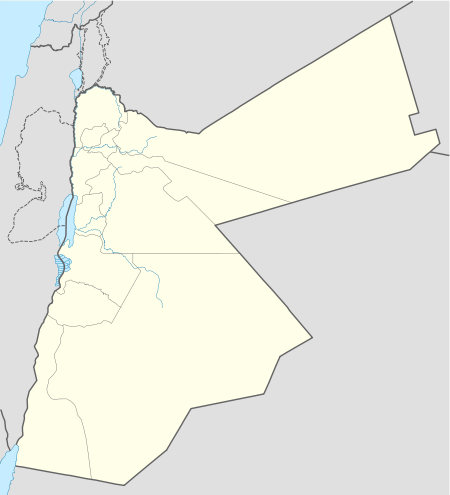Jawa, Jordan
Coordinates: 32°20′06″N 37°00′12″E / 32.33500°N 37.00333°E
- This article is about the Early Bronze Age proto-urban site in Jordan's basalt desert. For the Iron Age village in central Jordan, see Tall Jawa
 Shown within Jordan | |
| Location | Jordan |
|---|---|
| Region | Mafraq Governorate |
| Coordinates | 32°20′06″N 37°00′12″E / 32.335°N 37.003333°E |
Jawa is the site of the oldest proto-urban development in Jordan, dating from the late 4th millennium BC (Early Bronze Age). It is located in one of the driest areas of the Eastern Jordanian desert, in the Hauran region. The nearest dependable water is 60 km South-East at Azraq. Some contacts with the late stages of Uruk culture just before 3000 BC are indicated.
History
The town was built by a group of perhaps 2,000 migrants coming from the North or East. They had some understanding of urban life, as well as hydrology. It extended over 100,000 m2[1] and consisted of a walled town and extensive earthworks to divert winter floods from the Wadi into a series of reservoirs. This work would have had to be completed by the first winter after the groups arrival; otherwise they would not have survived the following summer. It is estimated the work would have taken a minimum workforce of 700.[2]
The population had large herds of sheep, goats and some cattle. Estimates based on bone counts indicate there may have been as many as 10,000 sheep and goats as well as 800 cattle. There were also 200 equids and 160 dogs.[3] From seed remains it is apparent that some of the water was also used for irrigation agriculture. The inhabitants ate barley, wheat, chickpeas, lentils and grapes.[4]
The lifetime of the town was extremely short. Its maximum population may have reached 5,000.[5] Within ten years the town walls had been violently breached. Archaeologists speculate that there was a civil war between the elite and communities which had grown up around the town walls. The establishment of a supply of water would have attracted the existing local population, whose origins are unknown.
There are many signs of earlier human activity. The desert is littered with unexplained stone structures. In particular the Desert Kites of which there are at least 60 close to Jawa. These structures, involving crude dry stone walls running hundreds of meters, are believed to have been used for trapping gazelles and other wild animals. The fact that activities related to Jawa have been found to have been built after the kites is taken as evidence that they pre-date 4000 BC, perhaps by thousands of years.[6]
There is a fortified building in the center of the ruins of the original town. It is believed to date from 2000 to 1500 BC and is not associated with any other stone structures.[7]
See also
- Jawa Dam (Jordan), a dam which was part of Jawa's water system
- Jericho
- Synoptic table of the principal old world prehistoric cultures
References
- ↑ Helms, Svend (1981) Jawa. Lost City of the Black Desert. Methuen. ISBN 0-416-74080-4. p.4
- ↑ Helms p.77
- ↑ Helms. p.189. Analysis by Ilse Kohler
- ↑ Helm. p.247. Analysis by G.H. Willcox
- ↑ Helm. p.130
- ↑ Helms, Svend (1981) Jawa. Lost City of the Black Desert. Methuen. ISBN 0-416-74080-4.
- ↑ Helms. p.6